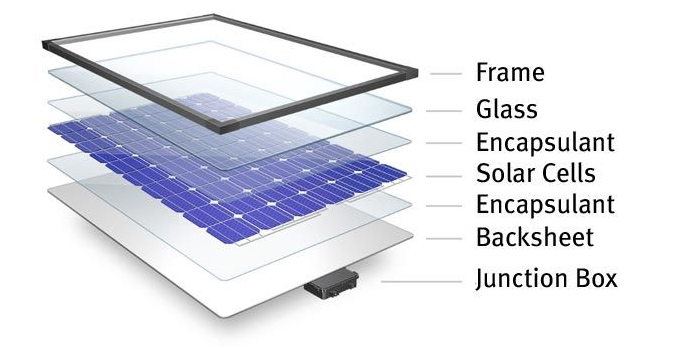Solar panels, also known as photovoltaic (PV) modules, are composed of several materials that work together to convert sunlight into electricity. The key materials that make up a solar panel include:
- Solar Cells (Photovoltaic Cells):
- Solar cells are the heart of a solar panel. They are responsible for converting sunlight into electricity. These cells are typically made from silicon, which is a semiconductor material. The two main types of silicon used in solar cells are monocrystalline silicon and polycrystalline silicon.
- Encapsulation Material:
- Solar cells are encapsulated between layers of protective material, usually made of glass or a durable plastic material called ethylene-vinyl acetate (EVA). This encapsulation protects the cells from environmental factors, such as moisture and dust, while allowing sunlight to pass through.
- Backsheet:
- The backsheet is the bottom layer of a solar panel, and it serves as additional protection for the cells. It is typically made of a weather-resistant polymer material, such as Tedlar or TPT (Tedlar/PET/Tedlar).
- Frame:
- Many solar panels have an aluminum frame around the edges to provide structural support and protect the panel from physical damage. The frame also allows for easy installation and mounting of the solar panel.
- Busbars and Interconnects:
- Busbars are conductive ribbons or wires on the front surface of the solar cells. They collect the electrical current generated by the cells and carry it to the panel’s output terminals.
- Interconnects are the conductive wires that connect individual solar cells within the module, allowing them to work together to generate electricity.
- Junction Box:
- The junction box is a critical component on the back of the solar panel. It contains electrical connections and diodes that manage the flow of electricity from the solar cells. The junction box also typically has connectors for easy wiring to the rest of the solar system.
- Anti-Reflective Coating:
- Some solar panels have an anti-reflective coating on the front surface of the glass to reduce reflection and increase the amount of sunlight that reaches the solar cells.
- Encapsulation Material (Rear):
- Similar to the front encapsulation material, a rear encapsulation layer made of EVA or another suitable material protects the backside of the solar cells and keeps everything together.
- Bypass Diodes (in some panels):
- In certain types of solar panels, bypass diodes are included to manage the effects of shading or partial cell malfunction. They help maintain the overall panel’s performance when part of it is not generating power.
These materials are carefully selected and engineered to ensure the durability, efficiency, and longevity of solar panels. The specific design and materials used can vary among different manufacturers and types of solar panels, but the fundamental principles remain consistent.


